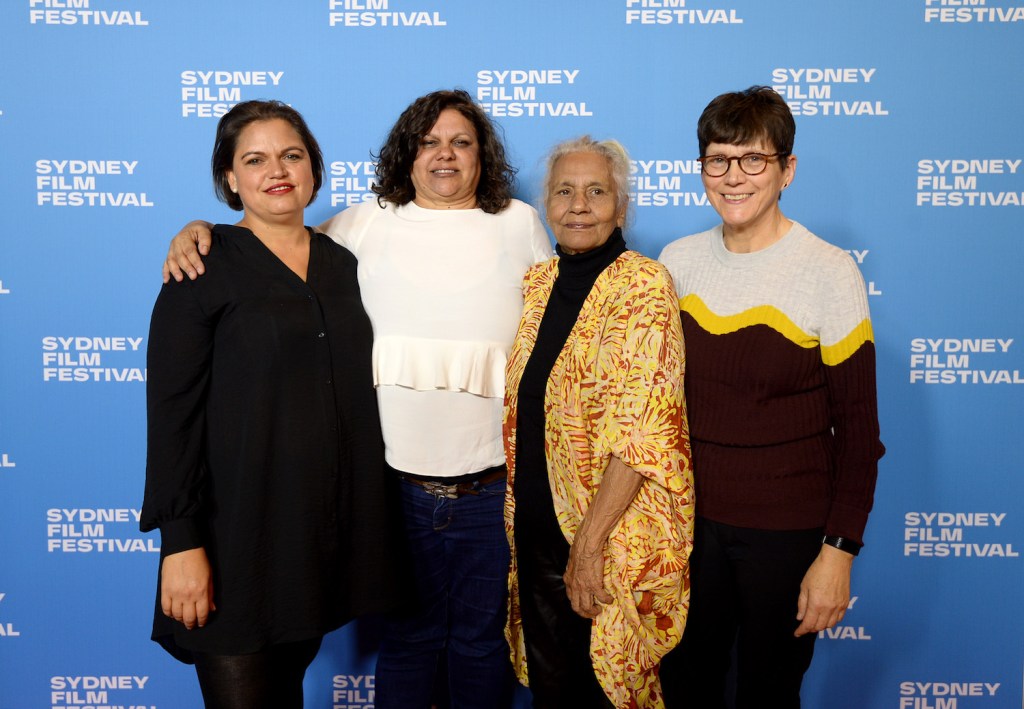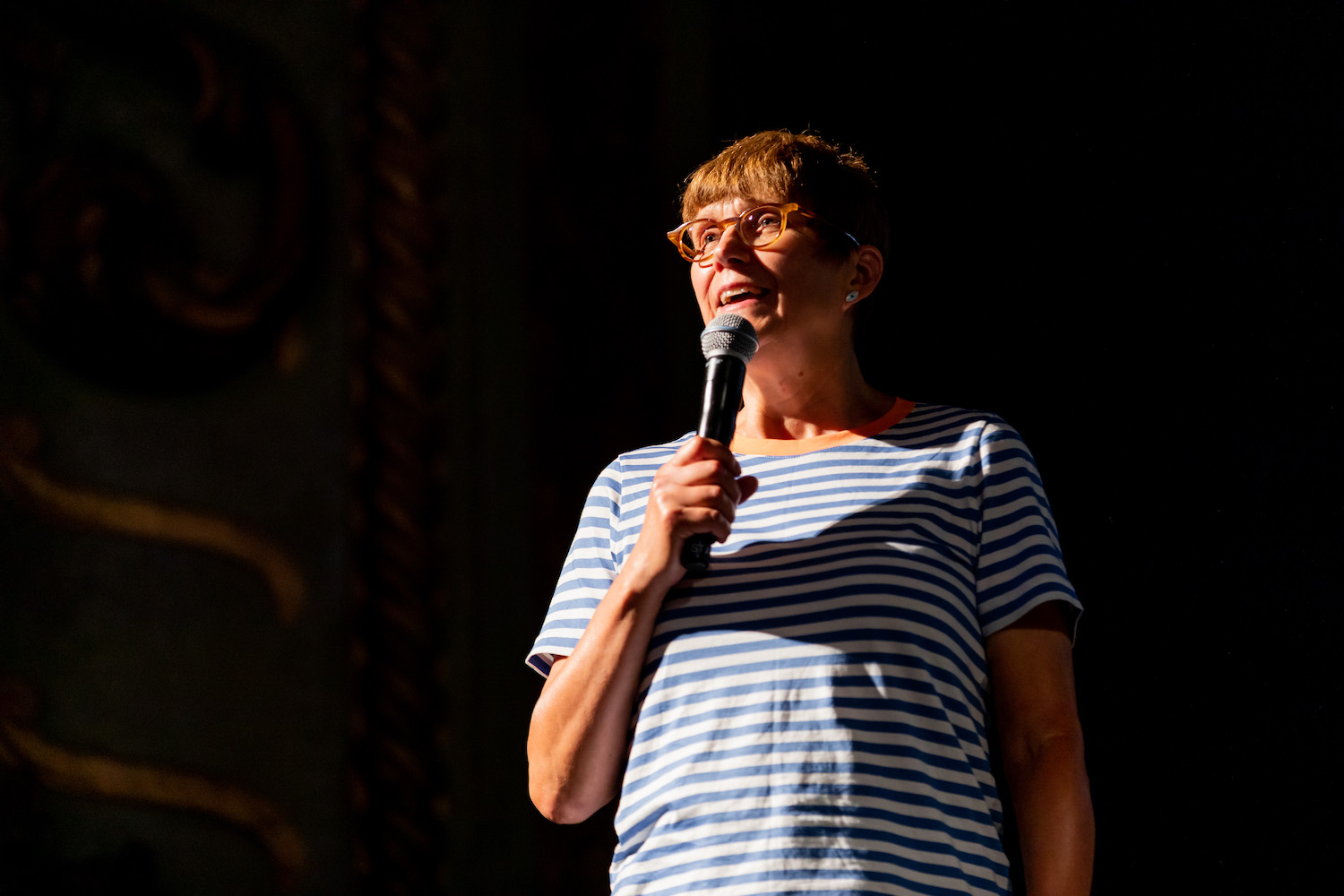Out of the 70 years of Sydney Film Festival’s existence, Jenny Neighbour has been there for 34.
Neighbour first joined the team back in 1989. While officially hired as assistant to festival director and CEO Paul Byrnes, in those days, the festival’s permanent staff hovered at 4-5, so people had to juggle multiple responsibilities. That meant Neighbour had oversight across programming, guest coordination, design, copywriting and marketing.
SFF headquarters was then an old terrace house in Glebe, with bedrooms for offices and a hole in the wall for a screening room.
“There was one of those beautiful, ornate plaster ceilings with a big hole for a 35mm projector,” Neighbour laughs.
There were no mobile phones and computers were still a new technology, so most festival correspondence was done by fax – or the odd telex, if they were looking to source titles from Russia or Eastern Europe.
In her early days, Neighbour’s desk would often be be covered by piles of VHSs, and later, CDs – divided into ‘watched’, ‘yet to be watched’ and ‘haven’t made a decision yet’.
Today, as festival’s program manager and documentary programmer, she still divides films the same way – albeit in her inbox. The advent of the screening link has meant the number of films she watches each year has grown “exponentially”.

Over her time with SFF, Neighbour has witnessed momentous change, not least of which being the shift from film to digital.
For the most part, it made much of the team’s work easier, in that they no longer had to deal with the expensive logistical challenge of shipping 35mm film reels around the world – sales agents would often only have a few subtitled prints.
However, the earliest days of digital – the festival used to show BetaCam and DigiBeta films – were a “technical nightmare” as they battled poor resolution and unsynced sound, or projectors that wouldn’t talk to players.
DCPs helped change the game in terms of access; films could come in later, be downloaded online in high resolution and there were no shipping costs.
By the same token, they increased filmmakers’ accessibility to the festival too. The Dendy Awards for Australian short films, first introduced in the ’70s, used to be limited to 16 and 35mm prints. As a result, the festival would only receive about 30-50 submissions a year – usually only from students or professionals – whereas today it receives 300-odd.
“It’s really changed the possibilities,” Neighbour says.
How the industry engages with festivals more generally has also shifted over Neighbour’s tenure.
When she first started, some sales agents used to see festivals as an “irritation”, whereas today they are allies in amplifying films.
“We were forever sending them faxes and [making] phone calls saying ‘Hey, we really want to show that film, can we have a decision?’ Now I think they all see festivals as part of a film’s life. It’s no longer, ‘If I can’t sell it, I’ll put it in the festival.'”
Similarly, while the team may still have to “beg and plead” with distributors occasionally, there is an understanding that the festival will try to work with them to achieve the best outcome for a title.
“We want to make sure that we put it in a slot in the festival that is going to work for them and how they’re going to profile the film. What we do in the way of marketing and publicity works in with what they’re thinking. So there’s a real mesh in that way, certainly locally,” Neighbour says.
“Internationally as well, Sydney Film Festival has a really great reputation. We’ve been going 70 years now, and we’re seen to have a really strong program. We have competitions – obviously there’s the opportunity for filmmakers to win money, and that’s always good, but there’s also a trust in the festival and our professionalism, and in how we present films.”
Today’s festival audience is different than when Neighbour first started too. Until the introduction of single tickets and multipasses in 2000, Sydney Film Festival had a subscription model, which meant people bought tickets for the full program – daytime or evening sessions – or for one week out of the two-week run. Tickets were capped to 2,000, around the number of seats in the festival’s official home, The State Theatre.
The decision to move to single tickets was a difficult one for the board to make, Neighbour reflects. Its audience was loyal – usually taking the full period off work, or rushing in afterwards – but the festival also had to field criticism that it was inaccessible to those who who didn’t have the time, money, or just were only interested in a handful of films.
“We had that audience that loved it how it was; they loved the fact that they were a community and there was a fight to get tickets.
“But it just wasn’t a model that we could keep going… Gayle Lake was the director at the time. We really opened up under that board and her leadership to say, ‘No, we want to be open doors for everyone.’ And since that time, the audience has built and built,” Neighbour says, noting it broke attendance records in 2019 at 188,000.
The history of SFF also maps the history of Sydney’s cinemas, particularly those in the CBD. When Neighbour first started the festival used satellite venues such as the Greater Union Pitt Centre, The Mandolin in Elizabeth Street, and Dendy Martin Place – all are now closed. In 2022, outside of the State Theatre and Event Cinemas George Street, the festival’s footprint covered inner suburbs via Palace Central and Palace Norton Street, Dendy Newtown, The Hayden Orpheum Picture Palace and Ritz Cinemas, and Western Sydney in the Casula Powerhouse.

As the festival’s documentary programmer, in the past few years Neighbour has steered SFF through a boom era for docs – something that has been both “great and tough”.
“You see some amazing films, and films that are changing the genre in a way that is stretching the boundaries. I think of something like Act of Killing, which is a documentary, but not a documentary. Visually amazing. Truth telling, yes, but not observational. That really changed a lot of things, as someone like Errol Morris did back a few decades before.
“But at the same time, there are now so many amazing films you have to juggle: Do you want this one or this one? And there’s a zeitgeist, when everybody’s making a film about the same thing.
“With all of that mix, you have to wade through and go: What is it that this film is saying about this subject? What does this offer in the overall program? What tonally does it offer; is it a different note? And also at the same time, wanting to have really diverse voices and authentic voices. We don’t have numbers; we don’t say we have to have so many from each region or so many different languages. But we do strive to really celebrate diversity and authenticity.”
SFF announced the first 12 titles for its 70th edition yesterday, with the full program to be released May 10. After a difficult few years for the industry and the world at large with COVID, Neighbour’s initial instinct when programming for the anniversary was to make selections that were fun or upbeat. However, given filmmakers have lived through these difficulties just like everyone else, they’re not necessarily making upbeat stories. Instead, she observes, they’re making films that are brave and inventive.
“I’m always incredibly impressed with how filmmakers react to things with such a different angle, that I go, ‘Oh, right’. I hope that’s something our audience will take away from the films I’ve selected; that they’ll go, ‘Oh, I didn’t think of that’. I think that’s an important thing that documentary can do.
“I’m paraphrasing Billy Bragg here, he said something like, ‘Music can’t change the world, but it can make you think the world can be changed’. And that for me is how I see documentary; that it gives you that possibility that there’s a different world there with different voices in it.“
After 34 years with Sydney Film Festival, Neighbour remains thrilled by the shared experience of the cinema; witnessing a film with an audience, especially when the filmmaker is in the same room.
“One of my favourite moments at the festival was when we had the filmmaker Alex Gibney in Sydney with his Scientology documentary Going Clear; we showed it at the State Theatre. Afterwards, I asked him what he thought when the crowd gave him a standing ovation. He said, ‘I was moved. And I’m rarely moved.’ To me that was like, ‘Wow’. He’s a very meticulous thinker, and yet the emotion of the moment gets to you every time.
“So for me, the sense of a film, a filmmaker and an audience connecting is so important.”


